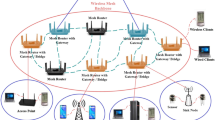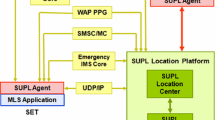Abstract
This manuscript presents a novel approach based on hybrid optimization techniques for planning Wireless Local Area Networks in two stages: i) network structure design for access point (AP) placement and channel assignment and ii) channel assignment enhancement. We consider two objective functions: network load balance and signal-to-interference-plus-noise ratio; and three hard constraints: maximum AP capacities, client demand attendance, and minimum coverage levels. The proposed algorithm delivers an approximation of the efficient solution set, considering the two functions described above. The results from two scenarios were compared to the following four approaches: two multiobjective evolutionary algorithms, a well-known commercial tool, and a greedy technique. Finally, the solutions were subjected to sensitivity analysis to validate their robustness regarding user mobility and AP failures.





Similar content being viewed by others
Notes
An ESS WLAN is a set of two or more access points that are seen by the client as a single Wi-Fi network.
References
(2008). IEEE 802.11r: Amendment 2: Fast Basic Service Set (BSS) Transition. IEEE Std 802.11r-2008 pp 1–126
Site survey tools @CISCO forum (2010). https://learningnetwork.cisco.com/thread/24648
Top Wireless WiFi Site Survey Software @MetaGeek forum (2010). http://forums.metageek.com/showthread.php?3412-Top-Wireless-WiFi-Site-Survey-Software
Adickes MD, Billo RE, Norman BA, Banerjee S, Rajgopal J (1999) Optimization of indoor wireless communication network layouts. Tech. rep., Dept. Industrial Engineering - University of Pittsburgh
Al-Bado M, Merz R, Sengul C, Feldmann A (2011) A site-specific indoor link model for realistic wireless network simulations. In: Proceedings of the 4th international ICST conference on simulation tools and techniques, SIMUTools ’11. Institute for computer sciences, ICST, Brussels, Belgium
Araújo J, Rodrigues J, Fraiha S, Gervasio H (2008) A WLAN planning proposal through computational intelligence and genetic algorithms hybrid approach. In: Proceedings of the Mobility conference
Balachandran A, Voelker G, Bahl P, Rangan P (2002) Characterizing user behavior and network performance in a public wireless LAN. In: Proceedings of the ACM sigmetrics
Balbi H, Fernandes N, Souza F, Carrano R, Albuquerque C, Muchaluat-Saade D, Magalhaes L (2012) Centralized channel allocation algorithm for IEEE 802.11 networks. In: Global information infrastructure and networking symposium (GIIS), pp 1–7
Bejerano Y, Han SJ (2006) Cell Breathing Techniques for Balancing the Access Point Load in Wireless LANs. Tech. rep. Bell Laboratories – Lucent Technologies
Bouckaert S, Vandenberghe W, Jooris B, Moerman I, Demeester P (2010) The w-ilab. t testbed. In: Testbeds and research infrastructures, vol 46, pp 145–154
Brélaz D (1979) New methods to color the vertices of a graph. Commun Assoc Comput 22:251–256
Carrano EG, Soares LAE, Takahashi RHC, Saldanha RR, Neto OM (2006) Electric distribution network multiobjective design using a problem-specific genetic algorithm. IEEE Trans Power Delivery 21(2):995–1005. https://doi.org/10.1109/TPWRD.2005.858779
Chia Y, Siew Z, Kiring A, Yang S, Teo K (2011) Adaptive hybrid channel assignment in wireless mobile network via genetic algorithm. In: International conference on hybrid intelligent systems, pp 511–516
Chiu DM, Jain R (1989) Analysis of the Increase and Decrease Algorithms for Congestion Avoidance in Computer Networks. Comput Netw ISDN Syst 17(1):1–14. https://doi.org/10.1016/0169-7552(89)90019-6
Croak P, Kim Y (2013) Site Survey Guidelines for WLAN Deployment. Tech. rep., Cisco Systems, Inc
Deb K, Agrawal RB (1995) Simulated binary crossover for continuous search space. Complex Syst 9:115–148
Deb K, Pratap A, Agarwal S, Meyarivan T (2002) A fast and elitist multiobjective genetic algorithm: NSGA-II. IEEE Trans Evol Comput 6(2):181–197
Deus FEG, Puttini RS, Molinaro L, Kabara J, Villalba LJ (2006) Survivable mechanism for IEEE 802.11 WLAN improvements. Lect Notes Comput Sci 5:808–818
Eisenblatter A, Geerdes HF, Gross J, Puñal O, Schweiger J (2010) A two-stage approach to WLAN planning: Detailed performance evaluation along the Pareto frontier. In: Modeling and optimization in mobile, ad hoc and wireless networks (wiopt), 2010, pp 227–236
Ekahau Inc, Reston VA, 2016 Ekahau Site Survey, version 8.6 [computer software]. http://www.ekahau.com/wifidesign/ekahau-site-survey
Farsi A, Achir N, Boussetta K (2014) WLAN planning: Separate and joint optimization of both access point placement and channel assignment. annals of telecommunications - annales des télécommunications, pp 1–12
Frühwirth T, Brisset P (2000) Placing base stations in wireless indoor communication networks. IEEE Intell Syst 15:49–53
Gamal M, Morsy E, Fathy A (2015) Multi-objective transmitters placement problem in wireless networks. In: Proceedings of the sixth international symposium on information and communication technology, soICT 2015. ACM, New York, pp 156–162
Garcia E, Vidal R, Paradells J (2005) New algorithm for frequency assignments in IEEE 802.11 wireless networks. In: Proceedings of the European wireless conference, pp 211–217
Gast MS (2005) 802.11 Wireless Networks: The Definitive Guide, Second Edition. O’Reilly Media, Inc
Gondran A, Baala O, Caminada A, Mabed H (2007) Joint optimization of access point placement and frequency assignment in WLAN. In: Proceedings of the IEEE/IFIP international conference in central asia, pp 1–5
Goudos SK, Plets D, Liu N, Martens L, Joseph W (2015) A multi-objective approach to indoor wireless heterogeneous networks planning based on biogeography-based optimization. Comput Netw 91:564–576
Horst K (2012) Ekahau Site Survey. Dign press
Jen Hsu W, Helmy A (2005) IMPACT: Investigation of Mobile-user Patterns Across University Campuses using WLAN Trace Analysis coRR abs/cs/0508009
Jebeli MS, Dehghan M (2014) Joint multicast routing and channel assignment in Multiradio Multichannel Wireless Mesh Networks using a multi objective algorithm. In: 2014 6th conference on Information and knowledge technology (IKT), pp 163–170
Kouhbor S, Ugon J, Rubinov A, Kruger A, Mammadov M (2006) Coverage in WLAN with minimum number of access points. In: IEEE 63rd Vehicular technology conference, 2006. VTC 2006-spring, pp 1166–1170
Kukkonen S, Lampinen J (2005) Gde3: the third evolution step of generalized differential evolution. In: 2005 IEEE Congress on evolutionary computation, vol 1, pp 443–450
Lee JH, Han BJ, Kim YD, Saxena N, Chung T (2009) Optimizing access point allocation using genetic algorithmic approach for smart home enviroments. J Comput 52(8):938–949
Leung K, Kim B (2003) Frequency assignment for IEEE 802.11 wireless networks. In: Proceedings of the IEEE vehicular technology conference
Li H, Zhang Q (2009) Multiobjective Optimization Problems with Complicated Pareto Sets, MOEA/D and NSGA-II. IEEE Trans Evol Comput 13(2):284–302. https://doi.org/10.1109/TEVC.2008.925798
Lima MP, Alexandre RF, takahashi RHC, Carrano EG (2017) A Comparative Study of Multiobjective Evolutionary Algorithms for Wireless Local Area Network Design. In: IEEE Congress on evolutionary computation
Lima MP, Carrano EG, Takahashi RHC (2012) Multiobjective planning of wireless local area networks (WLAN) using genetic algorithms. In: IEEE Congress on evolutionary computation, pp 1–8
Lima MP, Rodrigues TB, Alexandre RF, Takahashi RHC, Carrano EG (2014) Using evolutionary algorithms for channel assignment in 802.11 networks. In: IEEE Symposium series on computational intelligence
Liu N, Plets D, Goudos SK, Martens L, Joseph W (2015) Multi-objective network planning optimization algorithm: human exposure, power consumption, cost, and capacity. Wirel Netw 21(3):841–857
Magedanz T, Gavras A, Nguyen H, Chase J (2010) Testbeds and Research Infrastructures, Development of Networks and Communities: 6th International ICST Conference, TridentCom 2010, Berlin, Germany, May 18-20, 2010, Revised Selected Papers Springer Berlin Heidelberg
Mahonen P, Riihijarvi J, Petrova M (2007) Frequency allocation for WLANs using graph coloring techniques. Ad Hoc & Sensor Wireless Net 3:121–139
Mateus GR, Loureiro AA, Rodrigues RC (2001) Optimal network design for wireless local area network. Oper Res Int Journal 106:331–345
Mishra A, Banerjee S, Arbaugh W (2005) Weighted coloring based channel assignment for WLANs. In: Proceedings of the Mobile computing and communications review
Moreno J, Domingo M, Valle L, Lopez JR, Torres RP, Basterrechea J (2015) Design of Indoor WLANs: combination of a ray-tracing tool with the BPSO method. IEEE Antennas Propag Mag 57(6):22–33
Moura H, Bessa GVC, Vieira MAM, Macedo DF (2015) Ethanol: software defined networking for 802.11 wireless networks IFIP/IEEE international symposium on integrated network management (IM)
Nagy L, Farkas L (2000) Indoor base station location optimization using genetic algorithms. In: The 11th IEEE international symposium on personal, indoor and mobile radio communications, pp 843–846
Ohatkar S, Bormane D (2013) Channel allocation technique with genetic algorithm for interference reduction in cellular network. In: 2013 annual IEEE of India conference (INDICON), pp 1–6
Rappaport TS (2002) Mobile radio propagation: large-scale path loss, 2nd edn. Prentice Hall, Upper Saddle River
Riley GF, Henderson TR (2010) The NS-3 network simulator. In: Wehrle K, Güneş M, Gross J (eds) Modeling and Tools for Network Simulation. 1st edn. Springer
Scully T, Brown KN (2009) Wireless LAN load balancing with genetic algorithms. In: Proceedings of the Knowledge based systems, pp 529–534
Tarôco CG, Takahashi RHC, Carrano EG (2016) Multiobjective planning of power distribution networks with facility location for distributed generation. Electr Power Syst Res 141:562–571
Vanhatupa T, Hännikäinen M, Hämäläinen TD (2007) Evaluation of throughput estimation models and algorithms for WLAN frequency planning. Comput Netw 51(11):3110–3124
Zhang J, Tan K, Zhao J, Wu H, Zhang Y (2008) A Practical SNR-guided Rate Adaptation. In: INFOCOM. IEEE, pp 2083–2091
Zhang Z, Di X, Tian J, Zhu Z (2017) A multi-objective WLAN planning method. In: 2017 International conference on information networking (ICOIN), pp 86–91
Zhao W, Nishiyama H, Fadlullah Z, Kato N, Hamaguchi K (2016) DAPA: capacity optimization in wireless networks through a combined design of density of access points and partially overlapped channel allocation. IEEE Trans Veh Technol 65(5):3715–3722
Zheng Y, Baala O, Caminada A (2010) Optimization model for an Indoor WLAN-based Positioning System. In: 2010 international conference on Indoor positioning and indoor navigation (IPIN), pp 1–7
Zola E, Barcelo-Arroyo F (2013) Characterizing User Behavior in a European Academic WiFi Network. Int J Handheld Comput Res 4:55–68
Acknowledgments
The authors would like to thank Brazilian agencies CAPES, CNPq, and FAPEMIG for financial support; Ekahau, Inc. for providing a functional version of Ekahau Site Survey software for seven-day testing; and Charles F. S. Vardiero and Prof. Felipe Campelo for their careful review of our manuscript.
Author information
Authors and Affiliations
Corresponding author
Rights and permissions
About this article
Cite this article
Lima, M.P., Takahashi, R.H.C., Vieira, M.A.M. et al. Hybrid multicriteria algorithms applied to structural design of wireless local area networks. Appl Intell 48, 3653–3671 (2018). https://doi.org/10.1007/s10489-018-1165-7
Published:
Issue Date:
DOI: https://doi.org/10.1007/s10489-018-1165-7




